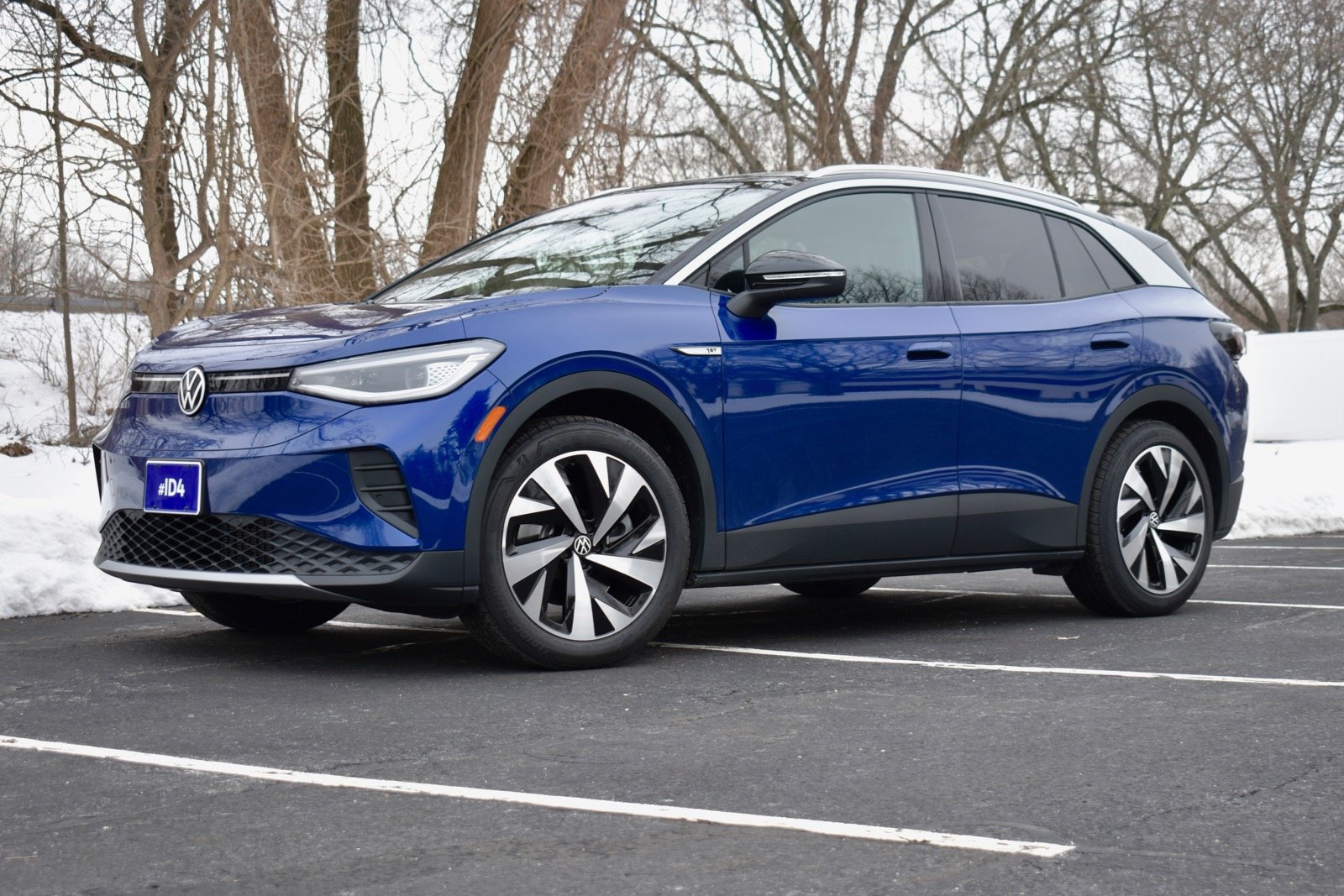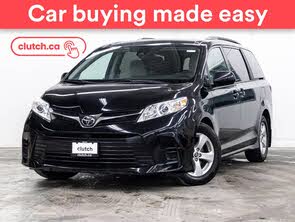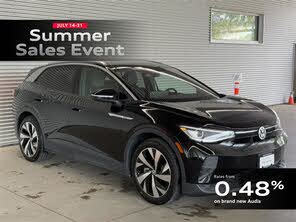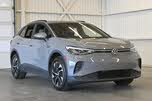2020 Toyota Sienna vs 2021 Volkswagen ID.4
Overview | |
MSRP$29,715 | MSRP$39,995 |
Listings57 | Listings9 |
Ratings & Reviews | |
User Reviews | User Reviews |
Expert reviews7.8 out of 10 | Expert reviews7.3 out of 10 |
Pros
| |
2020 Toyota Sienna Reviews SummarySince the second half of the 20th century, each decade has had a hot-topic family car, and, as we’ve noted in a number of reviews this year, the crossover is our current darling vehicle. Before the crossover, there were big, truck-based SUVs. Before that, there were station wagons. And for the past 35 years, there's always been the minivan. The Dodge Caravan has been widely considered the Patient Zero of the minivan segment. From there, seemingly everyone joined the party, including Toyota, Nissan, Ford, Chevy, GMC, Volkswagen, Oldsmobile, and more. Heck, even Mercury had a “Nautica Edition” version of the Villager. The minivan was king once, the crossover is king now, and some other type of vehicle will likely dominate in the near future. But in all this, the 7- and 8-passenger minivans will always represent the ultimate in versatility. The crossover is an image-forward fad with a dash of usability, but the minivan continues to prove itself as the pinnacle of practicality. The 2020 Toyota Sienna is neither the newest nor flashiest minivan out there, but when you absolutely need space for people and gear, there’s nothing better. Additionally, as of 2020 the Sienna is the only minivan to offer all-wheel drive (AWD), which is something specifically desired by many car buyers. | |
2021 Volkswagen ID.4 Reviews SummaryThe “Dieselgate” emissions scandal forced Volkswagen to double down on electric cars, and now we’re finally seeing the first result of that: the 2021 Volkswagen ID.4 electric crossover. VW has made an electric car before, but its last attempt, the e-Golf, was built to satisfy emissions standards, not rack up sales. It was barely advertised, and it was sold only in certain locations. With the ID.4, it will launch in the three largest Canadian EV markets—British Columbia, Quebec, and Ontario—and will even be built in North America, in Chattanooga, Tennessee, starting in 2022. Volkswagen views the ID.4 as a rival not to other EVs, but to mainstream gasoline vehicles like the Honda CR-V and Toyota RAV4. Being late to the party means there are already several other EVs trying to coax new-car buyers away from internal combustion, however. If you want a reasonably priced EV, the Nissan Leaf, Hyundai Kona Electric, and Kia Niro EV already exist, and General Motors has the 2022 Chevrolet Bolt EUV—a new variant of the Chevy Bolt EV with a crossover body style similar to the Volkswagen. Our test car was an ID.4 1st Edition, a U.S.-only model released to commemorates the car’s launch. Its closest Canadian equivalent is the ID.4 RWD Pro with the Statement Package. | |
Popular Features & Specs | |
Engine3.5L 296 hp V6 | Engine201 hp Electric |
Drive TrainFWD | Drive TrainRWD |
Seating Capacity2 | Seating Capacity5 |
Horsepower296 hp @ 6200 rpm | Horsepower |
EV Battery Capacity | EV Battery Capacity82 kWh |
MPG City19 | MPG City104 |
MPG Highway26 | MPG Highway89 |
Battery Charge Time (240V) | Battery Charge Time (240V)8 hours |
Engine | |
Engine Name3.5L 296 hp V6 | Engine Name201 hp Electric |
Torque263 lb-ft @ 4700 rpm | Torque |
Horsepower296 hp @ 6200 rpm | Horsepower |
Battery Charge Time (240V) | Battery Charge Time (240V)8 hours |
DrivetrainFWD | DrivetrainRWD |
Fuel Economy | |
EV Battery Capacity | EV Battery Capacity82 kWh |
MPG City19 | MPG City104 |
MPG Highway26 | MPG Highway89 |
Interior | |
Seating Capacity2 | Seating Capacity5 |
Safety | |
Front Crash Overall4 | Front Crash Overall5 |
Side Crash Overall5 | Side Crash Overall5 |
Dimensions & Capacity | |
Cargo Space | Cargo Space30.3 cu ft |
Curb Weight4375 lbs | Curb Weight4517 lbs |
Height68.9 in | Height64.4 in |
Length200.2 in | Length180.5 in |
Width78.1 in | Width72.9 in |
Wheelbase119.3 in | Wheelbase108.9 in |
Maximum Payload | Maximum Payload1347 lbs |
Number of doors4 | Number of doors4 |
Overview | ||
MSRP | $29,715 | $39,995 |
Listings | ||
Ratings & Reviews | ||
User reviews | ||
Expert reviews | 7.8 out of 10Read full review | 7.3 out of 10Read full review |
Pros & cons | Pros
| |
Summary | Since the second half of the 20th century, each decade has had a hot-topic family car, and, as we’ve noted in a number of reviews this year, the crossover is our current darling vehicle. Before the crossover, there were big, truck-based SUVs. Before that, there were station wagons. And for the past 35 years, there's always been the minivan. The Dodge Caravan has been widely considered the Patient Zero of the minivan segment. From there, seemingly everyone joined the party, including Toyota, Nissan, Ford, Chevy, GMC, Volkswagen, Oldsmobile, and more. Heck, even Mercury had a “Nautica Edition” version of the Villager. The minivan was king once, the crossover is king now, and some other type of vehicle will likely dominate in the near future. But in all this, the 7- and 8-passenger minivans will always represent the ultimate in versatility. The crossover is an image-forward fad with a dash of usability, but the minivan continues to prove itself as the pinnacle of practicality. The 2020 Toyota Sienna is neither the newest nor flashiest minivan out there, but when you absolutely need space for people and gear, there’s nothing better. Additionally, as of 2020 the Sienna is the only minivan to offer all-wheel drive (AWD), which is something specifically desired by many car buyers. | The “Dieselgate” emissions scandal forced Volkswagen to double down on electric cars, and now we’re finally seeing the first result of that: the 2021 Volkswagen ID.4 electric crossover. VW has made an electric car before, but its last attempt, the e-Golf, was built to satisfy emissions standards, not rack up sales. It was barely advertised, and it was sold only in certain locations. With the ID.4, it will launch in the three largest Canadian EV markets—British Columbia, Quebec, and Ontario—and will even be built in North America, in Chattanooga, Tennessee, starting in 2022. Volkswagen views the ID.4 as a rival not to other EVs, but to mainstream gasoline vehicles like the Honda CR-V and Toyota RAV4. Being late to the party means there are already several other EVs trying to coax new-car buyers away from internal combustion, however. If you want a reasonably priced EV, the Nissan Leaf, Hyundai Kona Electric, and Kia Niro EV already exist, and General Motors has the 2022 Chevrolet Bolt EUV—a new variant of the Chevy Bolt EV with a crossover body style similar to the Volkswagen. Our test car was an ID.4 1st Edition, a U.S.-only model released to commemorates the car’s launch. Its closest Canadian equivalent is the ID.4 RWD Pro with the Statement Package. |
Video | ||
Popular Features & Specs | ||
Engine | 3.5L 296 hp V6 | 201 hp Electric |
Drive Train | FWD | RWD |
Seating Capacity | 2 | 5 |
Horsepower | 296 hp @ 6200 rpm | |
EV Battery Capacity | 82 kWh | |
MPG City | 19 | 104 |
MPG Highway | 26 | 89 |
Battery Charge Time (240V) | 8 hours | |
Engine | ||
Engine Name | 3.5L 296 hp V6 | 201 hp Electric |
Torque | 263 lb-ft @ 4700 rpm | |
Horsepower | 296 hp @ 6200 rpm | |
Battery Charge Time (240V) | 8 hours | |
Drivetrain | FWD | RWD |
Fuel Economy | ||
EV Battery Capacity | 82 kWh | |
MPG City | 19 | 104 |
MPG Highway | 26 | 89 |
Interior | ||
Seating Capacity | 2 | 5 |
Safety | ||
Front Crash Overall | 4 | 5 |
Side Crash Overall | 5 | 5 |
Dimensions & Capacity | ||
Cargo Space | 30.3 cu ft | |
Curb Weight | 4375 lbs | 4517 lbs |
Height | 68.9 in | 64.4 in |
Length | 200.2 in | 180.5 in |
Width | 78.1 in | 72.9 in |
Wheelbase | 119.3 in | 108.9 in |
Maximum Payload | 1347 lbs | |
Number of doors | 4 | 4 |
The 2020 Toyota Sienna, in its third generation, had been around since the 2011 model year and received updates in 2018. Despite these updates, the 2020 version still felt somewhat dated, with occasional upscale touches. The front doors emitted a hollow "thud" when closed, indicating a lack of attention to fit and finish. The instrument panel appeared to be from Toyota's 2010 parts bin, though its simplicity made the controls user-friendly. The Sienna offered various trims, including CE, LE, SE, and XLE, each with distinct features. The base CE trim was well-equipped with 17-inch alloy wheels, remote keyless entry, and a 7-inch touchscreen with Apple CarPlay. The LE trim added family-friendly features like sliding dual power side doors and heated front seats. The SE trim included a power liftgate and leather upholstery, while the XLE added luxury touches like leather-trimmed seating and a power moonroof. The Nightshade Edition, available on the SE trim, added dark accents for a cooler look.
The 2021 Volkswagen ID.4 was designed as an electric vehicle from the ground up, showcasing a distinctive look compared to Volkswagen's gasoline models. It featured a streamlined profile with wheels pushed to the corners, departing from the straight lines and sharp angles of the Tiguan and Atlas crossovers. The ID.4 was part of VW's EV-specific MEB platform, following the European-market ID.3 hatchback. While it resembled the ID.3, the ID.4 aimed to appeal to North American crossover buyers. Its interior design combined Volkswagen's minimalism with a smartphone aesthetic, featuring piano black and matte plastic elements. The base ID.4 Pro came with a leather-wrapped steering wheel and cloth seats, with leatherette upholstery available in the Statement Package. The ID.4's interior was spacious, with good front headroom, but rearward visibility was hindered by thick rear pillars and a small back window.
The 2020 Toyota Sienna was equipped with a 3.5-litre V6 engine, producing 296 horsepower and 263 pound-feet of torque, paired with an eight-speed automatic transmission. It offered a Sport mode for livelier throttle and shift response, and a manual mode for towing up to 1,587 kilograms. The Sienna's powertrain sent power to the front wheels as standard, with AWD available on all trims except the base CE. AWD versions were limited to a 7-passenger configuration, a trade-off many buyers accepted for the added traction. The Sienna's FWD version delivered the best fuel efficiency, with 12.6 L/100 km in the city, 9.1 on the highway, and 11.0 combined. AWD versions returned 13.4 L/100 km city, 9.6 highway, and 11.7 combined. The Sienna handled surprisingly well for a minivan, with a low centre of gravity and broad base, though its steering response was twitchy at higher speeds.
The 2021 Volkswagen ID.4 offered two powertrain configurations. The base RWD version featured a single rear-mounted electric motor producing 201 horsepower and 229 pound-feet of torque, powered by an 82-kilowatt-hour battery pack. An AWD version added a second electric motor for a total output of 295 horsepower and 339 pound-feet of torque. The ID.4's RWD setup provided balanced handling, with the front wheels steering and the rear wheels driving. While not sporty, the ID.4 was tuned for comfort, with a smooth ride over bumps and potholes. The electric motor delivered ample power, and instantaneous torque made acceleration enjoyable. Unlike many EVs, the ID.4 did not offer aggressive regenerative braking for one-pedal driving, opting for a more traditional driving experience with friction brakes.
The 2020 Toyota Sienna excelled in cargo space, offering 4,247 litres, surpassing competitors like the Chrysler Pacifica and Honda Odyssey. However, accessing this space required removing the second-row seats, which was easier with captain's chairs than a bench. The Sienna's third-row seats folded seamlessly into the floor, but getting into the backseat could be challenging. Toyota also offered mobility access features, such as the Auto Access Seat, making it easier for those needing mobility conversions.
The 2021 Volkswagen ID.4 felt spacious compared to other EVs, with more front and rear headroom than competitors, though legroom was average. It offered 858 litres of cargo space with the rear seats in place and 1,818 litres with them folded, more than some EV rivals but less than gasoline crossovers like the Honda CR-V and Toyota RAV4. The ID.4 lacked a "frunk" for extra storage, prioritizing cabin space instead. The interior felt roomy, with good forward visibility, though rearward visibility was limited. The ID.4 featured a unique twist-grip gear selector on the dashboard, freeing up space on the centre console, though storage was limited.
The 2020 Toyota Sienna's base CE trim came with a 7-inch touchscreen infotainment system, supporting Apple CarPlay and Bluetooth connectivity. Higher trims offered an 8-inch screen, navigation, and a JBL 10-speaker premium audio system. The XLE Limited trim included Driver Easy Speak, an intercom system for communicating with rear passengers.
The 2021 Volkswagen ID.4 featured a standard 10-inch touchscreen infotainment system, with a 12-inch screen optional. It supported wireless Apple CarPlay and Android Auto, with a 5.3-inch display screen serving as the instrument cluster. Haptic touchpads replaced traditional switchgear, though they were challenging to use without tactile feedback. The ID.4 included a natural-language voice-control system and ID.Light, a light strip communicating information to the driver. While some features felt gimmicky, the touchscreen was well-positioned with smart graphics and easy-to-navigate menus.
The 2020 Toyota Sienna came standard with Toyota Safety Sense (TSS-P), including lane-departure alert, lane-keep assist, forward-collision warning, dynamic cruise control, and automatic high beams. Blind-spot monitoring and rear cross-traffic alert were available on SE models and above. The Sienna earned five stars from the NHTSA and a "Good" rating from the IIHS, with its driver-assistance features rated "Superior."
The 2021 Volkswagen ID.4 received a Top Safety Pick+ rating from the IIHS and a five-star rating from the NHTSA for RWD versions. It offered driver aids like forward-collision warning, automatic emergency braking, blind-spot monitoring, lane-keep assist, and adaptive cruise control. New features included Travel Assist, adding automated lane centring, and Emergency Assist, stopping the car if the driver is incapacitated. Travel Assist performed well, smoothly following curves and responding to acceleration and deceleration.
CarGurus highlights

According to CarGurus experts, the overall rating for the 2020 Toyota Sienna is 7.8 out of 10, while the 2021 Volkswagen ID.4 scores 7.3 out of 10. Based on these ratings, the Toyota Sienna is the recommended choice, offering a combination of practicality, safety, and proven performance that edges out the innovative but less highly rated ID.4.
Choose the 2020 Toyota Sienna if:
- You need a minivan with class-leading cargo space and family-friendly features.
- You value a vehicle with a proven track record and comprehensive safety features.
- You prefer a traditional gasoline engine with available AWD for added traction.
Choose the 2021 Volkswagen ID.4 if:
- You want an electric vehicle with a distinctive design and spacious interior.
- You appreciate advanced technology features and a modern infotainment system.
- You seek a comfortable ride with balanced handling and ample power.
CarGurus highlights

According to CarGurus experts, the overall rating for the 2020 Toyota Sienna is 7.8 out of 10, while the 2021 Volkswagen ID.4 scores 7.3 out of 10. Based on these ratings, the Toyota Sienna is the recommended choice, offering a combination of practicality, safety, and proven performance that edges out the innovative but less highly rated ID.4.
Choose the 2020 Toyota Sienna if:
Shop Now- You need a minivan with class-leading cargo space and family-friendly features.
- You value a vehicle with a proven track record and comprehensive safety features.
- You prefer a traditional gasoline engine with available AWD for added traction.
Choose the 2021 Volkswagen ID.4 if:
Shop Now- You want an electric vehicle with a distinctive design and spacious interior.
- You appreciate advanced technology features and a modern infotainment system.
- You seek a comfortable ride with balanced handling and ample power.

By: CarGurus + AI
At CarGurus, our team of experienced automotive writers remain at the heart of our content operation, conducting hands-on car tests and writing insightful guides that are backed by years of industry experience. To complement this, we are harnessing AI to make our content offering more diverse and more helpful to shoppers than ever. To achieve this, our AI systems are based exclusively on CarGurus content, ratings and data, so that what we produce is both unique to CarGurus, and uniquely helpful to car shoppers.
























































